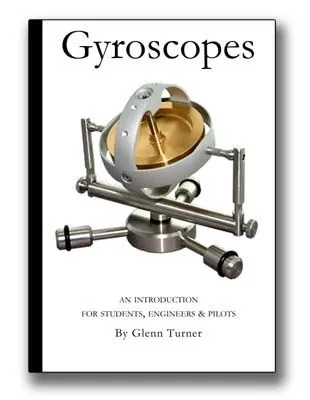Gyroscopes - An Introduction
for Students, Engineers and Pilots
Preface
This book was written as a response to a lack of publications offering easily understandable information on gyroscopes. This book aims to fill the gap between dictionary definitions and the all too often highly mathematical books on gyroscopes. With the aid of illustrations you will be shown the principles of gyroscopes including precession and nutation, where and how gyroscopes are used, practical mathematical examples and some of the history of gyroscopes. It will also dispel some of the myths and misunderstandings associated with gyroscopes and discuss the taboo subject of gyroscopic propulsion. Many students will not have come across a gyroscope before and the initial concepts can seem daunting. This book will try to guide you through this process and give you a good foundation.
Who is the book for ? This book will be useful for trainee pilots becoming accustomed to gyroscopes. Physics teachers and students looking for teaching material on gyroscopes, nutation and precession. Engineers wanting to calculate basic gyroscopic forces will be able to use the book as a reference, practical examples and illustrations will guide you through this process.
The book includes topics on :
- The Parts of a Gyroscope
- Basic gyroscope design
- How gyroscopes are made
- Machining and casting gyroscopes
- Balancing a gyroscope
- Behaviour of gyroscopes
- Gyroscopes and Six degrees of freedom
- RPM to Radians Conversion
- Conversion of Torque into Force
- Precession Mathematics – Real world Examples
- An example of a more powerful gyroscope
- Angular Momentum, Inertia and Spin Velocity Pyramid
- Gyroscopic Forces Acting on an Aircraft
- Precession caused by Gravity
- Spin direction and precession direction
- The cause of precession – Part 1
- The cause of precession - Part 2 (Piano Wire Experiment)
- Nutation
- Gimbal lock
- Why do three gimbals reduce the chance of gimbal lock?
- Tumbling
- Gyroscopic Drift
- Rate Gyroscopes
- Coriolis Force
- Gyroscope Applications
- Digital Gyrostabilisers for camcorders, cameras, and phones
- Mechanical Camera Gyrostabilizers
- Toys
- Cars
- Phones and tablets (as a means of control)
- Planes
- Tanks
- Rockets/Missiles
- V2 Rocket and the Pendulous Integrating Gyroscopic Accelerometer
- Helicopters (precession caused by rotors)
- Computer mice / pointing devices
- Sensor in human interface devices (controllers)
- Bullets and shells (and rifling)
- Spacecraft / CMG (Control Moment Gyroscopes)
- Completely mechanical gyrostabilisers
- Gyrostabilisers for ships
- Robots and Various Automation
- Robots using Gyroscopes for moment
- Torpedoes
- Golf gyroscope training aid
- Balls sports including Ruby and American Football
- Yo-Yos, spinning tops and diabolos
- Flip over tops / tippe tops
- Gyrocompasses in Aircraft
- Artificial horizons in Aircraft
- Gyrocompasses in Ships
- Drilling / Surveying
- Gyrobus (energy storage)
- Segway
- Uses that have not been fully explored
- Gyrocars
- Shilovsky Gyrocar (1912)
- Ford Gyron
- Gyro-X (1967)
- Ernest F. Swinney, Harry Ferreira and Louis E. Swinney monorail
- Gyro Hawk Gyro Cycle (Around 1993)
- Gyronaut X-1
- Uno (dicycle) 2008
- Lit Motors Gyrocar (2010)
- General Motors PUMA / EN-V concept
- Monorails
- Schilowsky gyrostatic monorail
- The Brennan monorail
- Launceston Steam Railway monorail
- August Scherl Monorail
- Swinney-Ferreira Gyro Dynamics Inc
- Unibikes / Monobikes (single wheeled bikes)
- Honda U3-X
- Gyroscopes in Aircraft
- General configuration
- Vacuum/Suction powered gyroscopes
- Creating a vacuum using Venturi Tube
- Vacuum system using a dry air pump
- Vacuum system using wet pump
- Positive pressure air pump
- Electric Gyroscope
- Beyond physical spinning disks
- Piezo electric / MEMs gyroscopes
- Hybrid Piezo gyroscope(s) with accelerometers
- Ring Laser Gyroscope
- Fibre Optic Gyroscope (FOG)
- Hemispherical Resonator Gyroscope (HRG)
- Wave Inertia Effect
- Optical Cavity Gyroscope
- Examples of the gyroscopes used in aircraft instrumentation
- Attitude Indicator (AI)
- The Heading Indicator (HI)
- Turn Co-ordinator / Rate gyroscope
- Method for reducing/eliminating gimbal lock
- Automatic Pilot
- Different types of gyroscope technologies
- Common misconceptions and myths
- A gyroscope loses weight
- Dr Yevgeny Podkletnov
- Gyroscopes keep Segways upright
- Precessing provides ‘free’ energy
- Simplistic upwards force
- Using a gyroscope and as a power source
- Gyroscopic forces in a bicycle wheel keeping it up right
- Gyroscopic forces on motorcycle
- The Uno motorbike
- Gyrobike/Jyrobike – A bike to help children learn to ride 94
- Tips for toy gyroscopes
- Candle wax
- Super glue
- Cotton verses Nylon string
- Kelvar™ and Dyneema™ - reducing fraying
- Oiling
- Rubber starters
- How to wrap the string round the shaft
- Tip: A quicker way to start the gyroscope which also preserves the string
- Pin rather than a hole
- Lead in Toy Gyroscopes
- RPM of Toy gyroscopes
- Gyroscopic propulsion research
- Halteres - Gyroscopic forces in Nature
- Hurricanes and Coriolis Force
- History of gyroscopes






